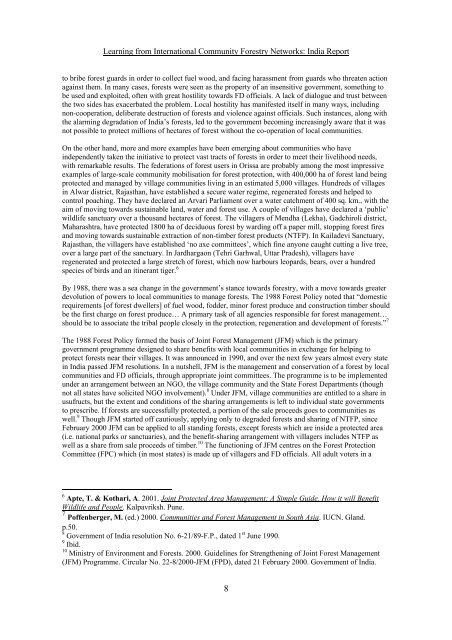Snapshots of International Community Forestry Networks: Country ...
Snapshots of International Community Forestry Networks: Country ...
Snapshots of International Community Forestry Networks: Country ...
You also want an ePaper? Increase the reach of your titles
YUMPU automatically turns print PDFs into web optimized ePapers that Google loves.
Learning from <strong>International</strong> <strong>Community</strong> <strong>Forestry</strong> <strong>Networks</strong>: India Report<br />
to bribe forest guards in order to collect fuel wood, and facing harassment from guards who threaten action<br />
against them. In many cases, forests were seen as the property <strong>of</strong> an insensitive government, something to<br />
be used and exploited, <strong>of</strong>ten with great hostility towards FD <strong>of</strong>ficials. A lack <strong>of</strong> dialogue and trust between<br />
the two sides has exacerbated the problem. Local hostility has manifested itself in many ways, including<br />
non-cooperation, deliberate destruction <strong>of</strong> forests and violence against <strong>of</strong>ficials. Such instances, along with<br />
the alarming degradation <strong>of</strong> India’s forests, led to the government becoming increasingly aware that it was<br />
not possible to protect millions <strong>of</strong> hectares <strong>of</strong> forest without the co-operation <strong>of</strong> local communities.<br />
On the other hand, more and more examples have been emerging about communities who have<br />
independently taken the initiative to protect vast tracts <strong>of</strong> forests in order to meet their livelihood needs,<br />
with remarkable results. The federations <strong>of</strong> forest users in Orissa are probably among the most impressive<br />
examples <strong>of</strong> large-scale community mobilisation for forest protection, with 400,000 ha <strong>of</strong> forest land being<br />
protected and managed by village communities living in an estimated 5,000 villages. Hundreds <strong>of</strong> villages<br />
in Alwar district, Rajasthan, have established a secure water regime, regenerated forests and helped to<br />
control poaching. They have declared an Arvari Parliament over a water catchment <strong>of</strong> 400 sq. km., with the<br />
aim <strong>of</strong> moving towards sustainable land, water and forest use. A couple <strong>of</strong> villages have declared a ‘public’<br />
wildlife sanctuary over a thousand hectares <strong>of</strong> forest. The villagers <strong>of</strong> Mendha (Lekha), Gadchiroli district,<br />
Maharashtra, have protected 1800 ha <strong>of</strong> deciduous forest by warding <strong>of</strong>f a paper mill, stopping forest fires<br />
and moving towards sustainable extraction <strong>of</strong> non-timber forest products (NTFP). In Kailadevi Sanctuary,<br />
Rajasthan, the villagers have established ‘no axe committees’, which fine anyone caught cutting a live tree,<br />
over a large part <strong>of</strong> the sanctuary. In Jardhargaon (Tehri Garhwal, Uttar Pradesh), villagers have<br />
regenerated and protected a large stretch <strong>of</strong> forest, which now harbours leopards, bears, over a hundred<br />
species <strong>of</strong> birds and an itinerant tiger. 6<br />
By 1988, there was a sea change in the government’s stance towards forestry, with a move towards greater<br />
devolution <strong>of</strong> powers to local communities to manage forests. The 1988 Forest Policy noted that “domestic<br />
requirements [<strong>of</strong> forest dwellers] <strong>of</strong> fuel wood, fodder, minor forest produce and construction timber should<br />
be the first charge on forest produce… A primary task <strong>of</strong> all agencies responsible for forest management…<br />
should be to associate the tribal people closely in the protection, regeneration and development <strong>of</strong> forests.” 7<br />
The 1988 Forest Policy formed the basis <strong>of</strong> Joint Forest Management (JFM) which is the primary<br />
government programme designed to share benefits with local communities in exchange for helping to<br />
protect forests near their villages. It was announced in 1990, and over the next few years almost every state<br />
in India passed JFM resolutions. In a nutshell, JFM is the management and conservation <strong>of</strong> a forest by local<br />
communities and FD <strong>of</strong>ficials, through appropriate joint committees. The programme is to be implemented<br />
under an arrangement between an NGO, the village community and the State Forest Departments (though<br />
not all states have solicited NGO involvement). 8 Under JFM, village communities are entitled to a share in<br />
usufructs, but the extent and conditions <strong>of</strong> the sharing arrangements is left to individual state governments<br />
to prescribe. If forests are successfully protected, a portion <strong>of</strong> the sale proceeds goes to communities as<br />
well. 9 Though JFM started <strong>of</strong>f cautiously, applying only to degraded forests and sharing <strong>of</strong> NTFP, since<br />
February 2000 JFM can be applied to all standing forests, except forests which are inside a protected area<br />
(i.e. national parks or sanctuaries), and the benefit-sharing arrangement with villagers includes NTFP as<br />
well as a share from sale proceeds <strong>of</strong> timber. 10 The functioning <strong>of</strong> JFM centres on the Forest Protection<br />
Committee (FPC) which (in most states) is made up <strong>of</strong> villagers and FD <strong>of</strong>ficials. All adult voters in a<br />
6<br />
Apte, T. & Kothari, A. 2001. Joint Protected Area Management: A Simple Guide. How it will Benefit<br />
Wildlife and People. Kalpavriksh. Pune.<br />
7<br />
P<strong>of</strong>fenberger, M. (ed.) 2000. Communities and Forest Management in South Asia. IUCN. Gland.<br />
p.50.<br />
8 st<br />
Government <strong>of</strong> India resolution No. 6-21/89-F.P., dated 1 June 1990.<br />
9<br />
Ibid.<br />
10<br />
Ministry <strong>of</strong> Environment and Forests. 2000. Guidelines for Strengthening <strong>of</strong> Joint Forest Management<br />
(JFM) Programme. Circular No. 22-8/2000-JFM (FPD), dated 21 February 2000. Government <strong>of</strong> India.<br />
8

















![CynefinFramework final [Read-Only]](https://img.yumpu.com/19017304/1/190x135/cynefinframework-final-read-only.jpg?quality=85)